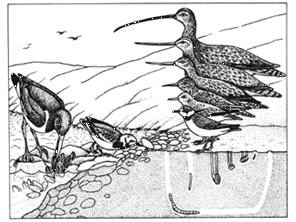Shorebird Feeding |
|||
|---|---|---|---|
|
Trying
to watch warblers feeding is a neck-and-patience-straining
exercise -- as Robert MacArthur found in the course of his
classic study of how these small insect-eaters divide their
food resources. Such "resource partitioning" by birds can be
observed in much greater comfort, however, while seated
behind a spotting scope (perhaps in a shelter) watching
waders forage in an estuary. In such a situation you might see an American Avocet, with its up-curved bill. Its bill seems less strange when you notice how the avocet uses it as a scythe, swinging it back and forth in the water, stirring the bottom and snatching up insects and small crustaceans thus exposed. Nearby a Black-necked Stilt stalks its victims in water six inches or more deep, a habitat inaccessible to the stubby-legged Western Sandpipers snatching invertebrates from the surface of an adjacent mud flat. On the same flat a Long-billed Curlew uses its nine-inch, curved, forceps-like bill to probe the burrow of a large marine worm, while a Dunlin uses its short beak to feel for smaller worms or insect larvae just below the mud's surface. A Semipalmated Plover collects |
||
|
prey from the
surface, hunting by sight and alone where the pattering feet
of a flock will not warn sensitive prey to withdraw into
their burrows Although crowded together at high tide, shorebirds begin to sort themselves out into preferred feeding habitats as the tide recedes. Least Sandpipers remain on drier, algae-covered mud; beyond them, Red Knots and Dunlins concentrate on bare, wet mud. Farther out, the long-legged Short-billed Dowitchers wade while rapidly probing the mud beneath the shallow water, accompanied by Greater Yellowlegs skimming prey from the water surface or swinging their bills back and forth to snare small fishes. On sandy, wave-washed soils Sanderlings dash nimbly back and forth at the very edge of the ebb and flow, probing the sand for tiny shrimp-like crustaceans. Ruddy Turnstones, as their name suggests, fill their bellies in quite a different way -- they turn over rocks, shells, and even cowpies to expose concealed prey and sometimes dig deeply into sand. Oystercatchers, similarly well named, can extract a mussel's meat from between its shells, but that's a story for another essay. In a single year, one oystercatcher can consume more than a hundred pounds of mussel meat. Indeed, each day many shorebirds take in about a third of their weight in food. When you see huge mixed-species flocks of shorebirds feeding on an estuary, you can view it as a tribute to the great biological productivity of those environments, and an example of the ways that evolution has managed to limit the degree to which each species must compete with others for its food. |
|||
| SEE:
MacArthur's Warblers;
Determining Diets;
How Do We Find Out About Bird Biology? Copyright ® 1988 by Paul R. Ehrlich, David S. Dobkin, and Darryl Wheye. |
|||
